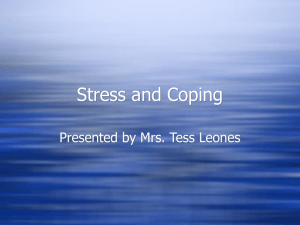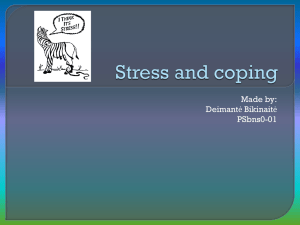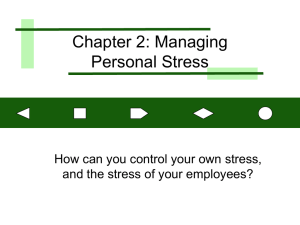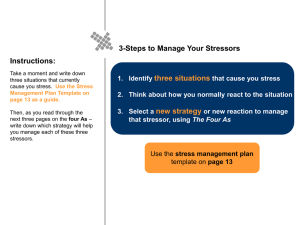What is stress?
advertisement
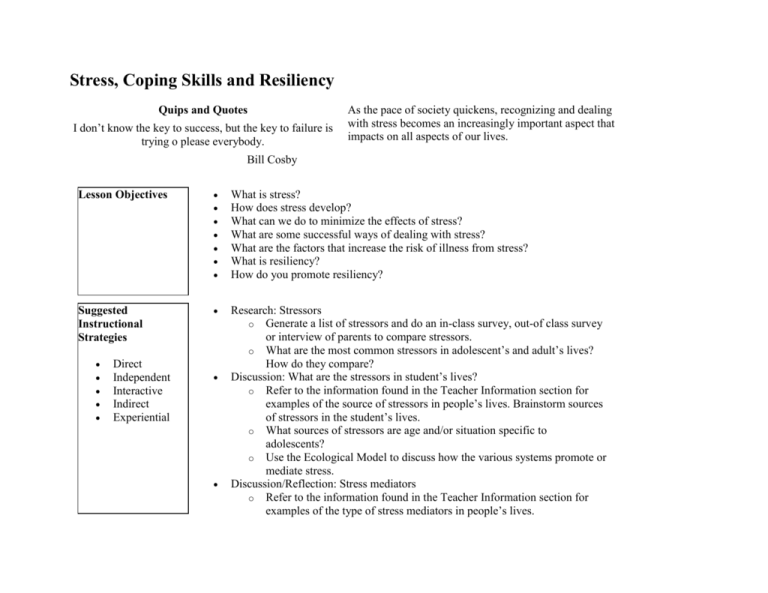
Stress, Coping Skills and Resiliency Quips and Quotes I don’t know the key to success, but the key to failure is trying o please everybody. As the pace of society quickens, recognizing and dealing with stress becomes an increasingly important aspect that impacts on all aspects of our lives. Bill Cosby Lesson Objectives What is stress? How does stress develop? What can we do to minimize the effects of stress? What are some successful ways of dealing with stress? What are the factors that increase the risk of illness from stress? What is resiliency? How do you promote resiliency? Suggested Instructional Strategies Research: Stressors o Generate a list of stressors and do an in-class survey, out-of class survey or interview of parents to compare stressors. o What are the most common stressors in adolescent’s and adult’s lives? How do they compare? Discussion: What are the stressors in student’s lives? o Refer to the information found in the Teacher Information section for examples of the source of stressors in people’s lives. Brainstorm sources of stressors in the student’s lives. o What sources of stressors are age and/or situation specific to adolescents? o Use the Ecological Model to discuss how the various systems promote or mediate stress. Discussion/Reflection: Stress mediators o Refer to the information found in the Teacher Information section for examples of the type of stress mediators in people’s lives. Direct Independent Interactive Indirect Experiential o Are there any that students use in times of stress? Discussion: Quotations o It’s incredibly easy to get caught up in the activity trap, in the busyness of life, to work harder and harder at climbing the ladder of success only to discover it’s leaning against the wrong wall (Steven R. Covey). o There is more to life than increasing its speed (Ghandi). Jigsaw: Theoretical perspectives and stress o Assign one of the six theoretical perspectives to a small group of students. Have each group explain and describe stress from its perspective. What would each group recommend for stress relief? Making Connections Self-identity and groups: o What is the nature of the relationship between self-identity and groups to which people belong? o How does an individual find and maintain a sense of self in group situations? o What are the dangers of losing self-identity in favour of a group identity? Resources Curriculum Support Materials: Theoretical Perspectives on Human Behaviour Curriculum Support Materials: The Ecological Model Lesson 4.5.12: Teacher Information What is stress? Canadian physician Hans Selye (1956) concluded that stress consists of a series of physiological reactions that occur in three phases: The alarm phase, in which your body mobilizes to meet the immediate threat or other stressor. Physiological responses include a boost in energy, tense muscles, reduced sensitivity to pain, the shutting down of digestion, a rise in blood pressure, and increased output of the adrenal hormones adrenaline, norepinephrine and cortisol. The resistance phase, in which your body attempts to resist or cope with a stressor that cannot be avoided, but which persists over time. During this phase, the physiological responses of the alarm phase continue, but these responses make the body more vulnerable to other stressors. The exhaustion phase, in which persistent stress depletes the body of energy and therefore increases vulnerability to physical problems and eventually illness. The same reactions that allow the body to respond effectively in the alarm and resistance phases are unhealthy as long-range responses (Tavris and Wade, 2000, p. 546). How does stress develop? Stressors Life changes and strains Catastrophic events Daily hassles Chronic stressors Stress mediators Cognitive appraisal Predictability Sense of control Coping resources and methods Social support Personality Stress reactions Physical Emotional Cognitive Behavioural Source: (Bernstein and Nash, 1999, p. 380) What can we do to minimize the effects of stress? Stress mediators include: Predictability and control: Uncertainty about when and if a certain stressor might occur tends to increase the stressor's impact. Predictable stressors tend to have less impact than those that are unpredictable. Stressors over which people believe they exert some control usually have less impact. The greatest threat to health and well-being occurs when people feel unable to control their circumstanceswhen they feel caught in a situation they cannot escape. Feelings of control can reduce or even eliminate the relationship between stressors and health. Coping resources and methods: People usually suffer less from a stressor if they have adequate coping resources (money, time) and effective coping methods (problem-focused techniques involve methods to alter or eliminate stress, or emotion-focused techniques that attempt to regulate the negative emotional effects). Social support consists of resources provided by other people, the friends and social contacts on whom you can depend for support. Social support refers not only to your relationship with others but also to the recognition that others care and will help. Personality: One element of the stress-resistant personality seems to be dispositional optimism, the belief or expectation that things will work out positively. People who tend to think of stressors as temporary and who do not blame themselves for bringing about the stressors appear to be less harmed by them (Bernstein and Nash, 1999, p. 380). What are some successful ways of dealing with stress? Category Examples Physical strategies Relaxation Meditation Massage Exercise Problem-oriented strategies Reduce negative emotions Problem-focused coping Cognitive strategies Reappraising the problem Learning from the problem Making social comparisons Cultivating a sense of humour Social strategies Relying on friends and family Helping others (Tavris and Wade, 2000, p. 567) What are the factors that increase the risk of illness from stress? Factors that increase the risk of illness from stress include: Environmental: Uncontrollable noise, poverty, lack of access to health care, persistent discrimination Experiential: Bereavement or divorce, traumatic events, chronic and severe job stress, unemployment Biological: Viral or bacterial infections, disease, genetic vulnerability Psychological: Toxic hostility, possibly chronic depression, emotional inhibition, pessimism, external locus of control, fatalism, feeling powerless Behavioural: Smoking, high-fat diet, lack of exercise, abuse of alcohol and other drugs, lack of sleep Social: Lack of supportive friends and relatives, low involvement in groups (Tavris and Wade, 2000, p. 569). What is resiliency? Resiliency is unusually good adaptation to severe and/or chronic stress, or the ability to rebound to or above pre-stress levels of adaptation (Saskatchewan Health, 1998, p. C1). How do you promote resiliency? To promote resiliency in people, you must decrease the risk factors and increase the protective factors. The major risk factors include an uptight temperament, poor parenting (especially during the first three years), family conflict/violence/mental illness, poverty and being powerless/marginalized/stigmatized. There are three aspects that serve to protect people: o Individual protectors, or protective personal characteristics such as low anxiety, good coping skills, autonomy, secure attachments, sense of control over their lives, having a mentor outside of the family, a good support network, and a positive outlook. o Protective family factors include parental involvement/caring/support, high but achievable expectations, participation by children welcomed, and the family endures/copes in the face of stressful events. o Protective communities demonstrate a cohesive and civil society, safety is not a concern, high equity and low marginalization, adequate recreation for all, resources are available, and the community is genuine and concerned, “accept you as a person, not as a stereotype”. To promote resiliency in high school youth, interventions include peer mentoring/conflict resolution, programs to prevent dropping out, preparation for being good partners/parents, preparation for transition to work; and provisions for teens with babies (Saskatchewan Health, 1998, p. C2-C6).


